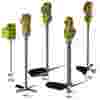What is meant by shear mixing?
Shear is the difference of velocity between two fluid vectors. When you apply shear to a non-newtonian fluid (fluid whose viscosity changes with shear), its viscosity will change:
- It decreases: pseudoplastic
- It increases: dilatant
- It becomes as solid above a mini shear: Bingham
- It decreases with time under shearing: thixotrope
- It increases with time under shearing: rheopectic
Shear depends on the velocity gradient in the fluid. Specific power (W/m3) can also give information on the shear stress.
What is the purpose of low shear mixing?
Some mixing processes require very low shear such as flocculation or polyelectrolyte. Shear will typically destroy flocs in the flocculation process. A gentle and low shear mixing is required. Low shear mixing can also be used for solid suspension, where high flow is required.




